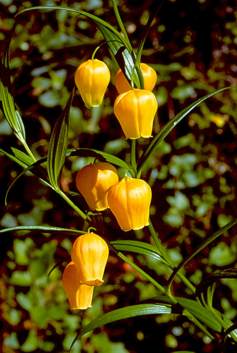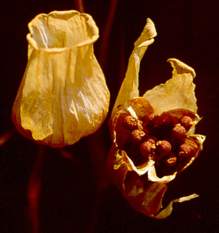Sandersonia aurantiaca
Sandersonia aurantiaca Hook.
Family: Colchicaceae
Common names: Christmas bells (Eng.); geelklokkie (Afr.); ushayabhici (Zulu); ihlamvu (Zulu)
Introduction
Seldom seen in cultivation in southern Africa, the highly ornamental, lantern-like flowers of Sandersonia aurantiaca are universally admired, and highly prized as long-lasting cut flowers and graceful container plants.

Description
Description
Sandersonia aurantiaca is an erect or suberect, deciduous, summer-growing geophyte reaching up to 1 m high, and the genus contains just one species. The subterranean storage organ or rootstock is a fairly deep-seated, stoloniferous corm consisting of two swollen, jointed lobes. New growth is produced in spring; the new rootstock and slender aerial stems are produced from a bud at the tip of one of the two old, swollen lobes. The lance-shaped leaves are arranged alternately along the stem and, unlike the closely related genera Gloriosa and Littonia, do not usually have tendrils at their tips.
Other southern African members of the Colchicaceae include the genera Androcymbium, Onixotis (formerly Dipidax ) and Wurmbea, while the largest genus, Colchicum, is found in the Mediterranean and western Asia.
The elegant, lantern-like flowers of S. aurantiaca are borne on long stalks produced in the leaf axils; they open from the bottom upwards and occur in shades of pale to deep orange. The fruit is a capsule containing many small, hard brown seeds, without a papery seed coat, unlike the much larger seeds of Gloriosa and Littonia.

The flowers of Sandersonia aurantiaca are sometimes confused with those of Littonia modesta - those of S. aurantiaca are distinctly lantern-shaped, whereas those of Littonia modesta are bell-shaped with flared tepals and have a peculiar, musty scent.
Distribution and habitat
Distribution description
Sandersonia aurantiaca flowers were once a common sight throughout its grassland and forest margin distribution range in the Eastern Cape, KwaZulu-Natal, Swaziland and southern Mpumalanga, but severe habitat loss from agricultural expansion and indiscriminate picking of flowers has made it a rare sight in the wild today; it is usually only seen in nature reserves. It occurs in deep, heavy soil on damp hill slopes in full sun.
Derivation of name and historical aspects
History
Sandersonia aurantiaca was discovered by the Scottish journalist and amateur botanist John Sanderson in KwaZulu-Natal in 1851, and was described by Sir William Hooker, director of the Royal Botanic Gardens, Kew, in Curtis's Botanical Magazine in 1853. The specific epithet aurantiaca is derived from Latin and refers to the orange colour of the flowers (between yellow and red). The common name, Christmas bells, is most fitting as the plants are usually seen in flower around Christmas-time in the wild.
Uses
Use
The rootstocks of Sandersonia aurantiaca have traditionally been used by the Zulu people as an aphrodisiac, and the leaves are also used in combination with other plants in bathing infusions as protection against evil. The compound colchicine is present in this species, and all parts of the plant should therefore be regarded as potentially toxic.

Growing Sandersonia aurantiaca
Grow
Unlike its close relatives Gloriosa and Littonia, Sandersonia aurantiaca is not as easily maintained in cultivation over an extended period, as the rootstocks have a tendency to rot, particularly in the absence of a dry winter rest period.
S. aurantiaca requires a well-drained and well-aerated slightly acid growing medium, containing some organic matter such as equal parts of finely sifted, well-decomposed acid compost, and coarse river sand or silica sand (swimming pool sand). Deep plastic pots with a diameter of 25 cm are recommended, and a 2-3 cm layer of stone chips should be placed over the holes to improve drainage. Two thirds of the pot should be filled with growing medium and a strong narrow stake placed in the centre, to which the delicate stems can be tied. In spring, three to five mature rootstocks can then be placed in a 1-2 cm layer of pure river sand or silica sand, ensuring that the rootstocks lie in a horizontal position. The rootstocks must be handled with care as they are rather brittle. The rest of the container can then be filled with growing medium.
After planting, the containers should be watered well, and then not again until the leaf shoots appear, after which a thorough soaking once per week is recommended. The containers should be placed in positions receiving morning sun and afternoon shade, or bright light for as much of the day as possible. The plants are tender and should be grown in the cool greenhouse in cold climates of the northern hemisphere. They can be successfully grown in deep bulb beds, provided that the dormant rootstocks are kept dry during the winter months.
The flowering time of S. aurantiaca in the wild is mid-December to January, but under cultivation in southern Africa it tends to start earlier, from late November onwards.
New Zealand bulb growers have successfully commercialised this plant, and in the mid-1990s it was that country's second-most important export cut flower crop after orchids.

Sandersonia aurantiaca is mainly propagated by seed and by division of the rootstock, and to a lesser extent, by in vitro propagation. Unlike Gloriosa and Littonia, which are very easily propagated by seed, the seeds of S. aurantiaca are notorious for their erratic germination. Propagation by seed is however still a recommended method for the enthusiastic home gardener, but beware, this long, drawn-out process is likely to test the patience of even the most resolute individual.
Sow freshly harvested seeds in late spring or early summer in deep seed trays, in the same medium recommended for mature rootstocks. Keep moist by watering regularly with a fine rose, and place the trays in a semi-shaded position with good ventilation, protected from heavy summer rain. Even from fresh seeds, a very low percentage will usually germinate during the first summer season. With the onset of autumn, allow the seed trays to gradually dry out and the few seedlings to go completely dormant over winter.
Begin watering again in late spring, and during this second growing season, many more seeds should germinate, and a few plants from the previous season may flower. Two-year-old rootstocks can be removed from the seed trays and be potted up into permanent pots, but do not discard the old growing medium in the seed trays as the remaining seeds will continue to germinate if they are watered every summer for a further two to three years. An alternative seed pre-sowing treatment is to soak them in water for 24 hours, then mix them with vermiculite and store in a fridge at 5-6º C for three months.
According to Finnie & Van Staden (1996), several other dormancy-breaking techniques are practised by commercial growers of Sandersonia in New Zealand. These include leaving the seeds in porous nets in a cold mountain stream for the winter, before sowing in spring. They also report that using one or a combination of increased oxygen tension, scarification, stratification, endosperm damage or lipid mobilization, significantly increases germination of Sandersonia seeds. The seedlings can bear flowers for the first time during their second season of growth, under ideal conditions, but usually first flowers are produced during their third season.
Propagation by division of the mature rootstock is a recommended method of increasing particular forms of this plant, which will be exactly true to type. Using a sharp knife, the mature rootstock is cut through the centre of the joint that holds the two lobes together, to produce two divisions, each with a piece of the joint as well as a lobe with a growth bud. The cut surface should be allowed to dry for a day or two, then dusted with a fungicide such as captab (e.g. Kaptan) and planted. This process is best undertaken in late winter, just before active growth begins. During the summer growth period, the old rootstock shrivels up and dies while a new rootstock is produced by the growth bud at the tip of one of the lobes. The growth bud at the tip of one of the lobes is always dominant over the bud at the tip of the other lobe, and under normal circumstances the latter fails to sprout. However, division of the rootstock stimulates the other growth bud to develop as well. Division is a useful method of propagation as two flowering stems can be obtained from one rootstock during the same growth season in which the procedure is carried out.
Sandersonia is not especially susceptible to pests. However, aphids may attack new foliage in early summer, while snout beetles sometimes damage the flower stems. Slugs and snails are partial to the foliage. Fungal rotting of the rootstock is the most important disease affecting these plants and it can be greatly reduced by growing them in a well-aerated, well-drained, sandy medium, and by ensuring that the rootstocks are kept in dry soil throughout the winter dormant period.
References
- Duncan, G.D. 1999. Christmas bells-the cultivation and propagation of Sandersonia aurantiaca. Veld & Flora 85: 178-180.
- Duncan, G.D. 2000. Grow bulbs. Kirstenbosch Gardening Series. National Botanical Institute, Cape Town.
- Du Plessis, N.M. & Duncan, G.D. 1989. Sandersonia. Bulbous plants of southern Africa. Tafelberg, Cape Town.
- Finnie, J.F. & Van Staden, J. 1996. Sandersonia aurantiaca Hook. (Christmas bells): micropropagation and in vitro production of colchicine. Biotechnology in Agriculture and Forestry 37: 355-369.
- Hutchings, A. 1996. Zulu medicinal plants. University of Natal Press, Pietermaritzburg.
- Pooley, E. 1998. A field guide to wild flowers of KwaZulu-Natal and the eastern region. Natal Flora Publications Trust, Durban.
Credits
Graham Duncan
Kirstenbosch National Botanical Garden
December 2006
Plant Attributes:
Plant Type: Bulb
SA Distribution: Eastern Cape, KwaZulu-Natal, Mpumalanga
Soil type: Sandy, Loam
Flowering season: Early Summer
PH: Acid, Neutral
Flower colour: Orange
Aspect: Full Sun, Morning Sun (Semi Shade)
Gardening skill: Challenging
Special Features:
Horticultural zones











Rate this article
Article well written and informative
Rate this plant
Is this an interesting plant?
Login to add your Comment
Back to topNot registered yet? Click here to register.